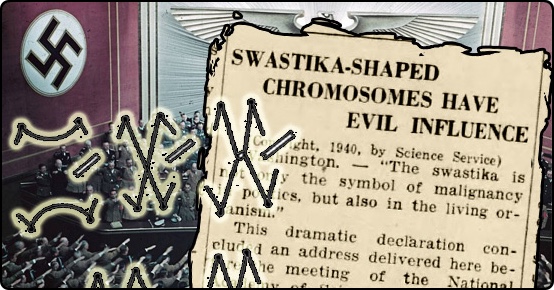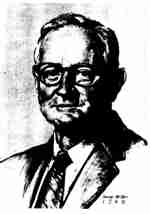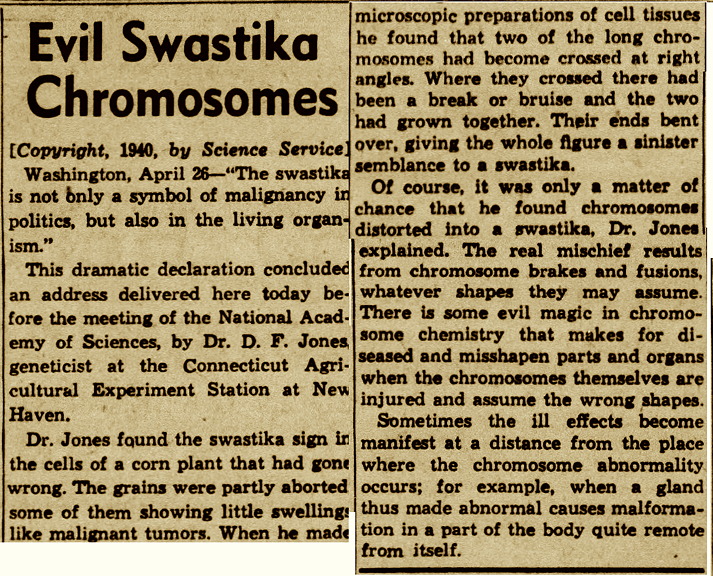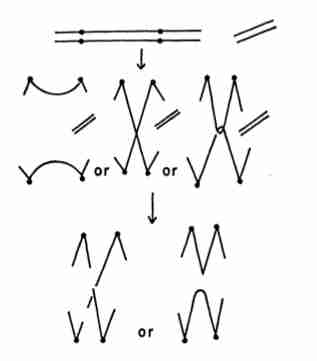The Swastika Chromosomes of D.F. Jones


D.F. Jones
Jones made the announcement during the annual meeting of the National Academy of Sciences, at the end of an otherwise quite dry presentation about "Growth changes resulting from chromosome arrangement." His announcement was so unusual that it promptly got picked up by the media. The Science News-Letter reported as follows:
Dr. Jones found the perverted Sign of the Crooked Cross in the cells of a corn plant that had gone wrong. The grains were partly aborted, some of them showing little swellings like malignant tumors. When he made microscopic preparations of cell tissues he found that two of the long chromosomes had become crossed at right angles. Where they crossed there had been a break or bruise and the two had grown together. Their ends had bent over, giving the whole figure a sinister semblance to a swastika.
For Jones, his discovery wasn't merely a meaningless curiosity but suggested parallels between politics and nature. The New York Times quoted him as saying, "The swastika is a sign of malignant growth not only in the political field but in living matter as well." This pronouncement, though patriotically anti-Nazi, didn't meet with universal approval. One columnist, Edwin C. Hill, argued that science should remain above politics:
we find this swastika-chromosome discovery hard to take, although the cancerous derivation of the symbol would seem to meet the mood of the moment in this country. Nature never tagged anything 'good' or 'evil.' In fact, she has been so remiss in this matter that she has left the argument wide open, in barroom discussions and university seminars and all between.

Baltimore Evening Sun - Apr 26, 1940
The Swastika-Chromosome Diagram
During his presentation, Jones showed a diagram of the swastika chromosomes. It's not clear what became of this diagram. It doesn't appear in any of his published papers. But I was curious to see it, so I contacted the archivist at the Connecticut Agricultural Experiment Station, who unfortunately didn't have any knowledge of it. However, after some more digging around in old journals, I concluded that it's possible the diagram made it into print in an article authored by Frances Clark and Frederick Copeland, published in the American Journal of Botany in April 1940 (the same month as Jones's presentation). The article, titled "Chromosome Aberrations in the Endosperm of Maize," included the following illustration of some maize chromosomes reforming into the shape of swastikas.

What makes it probable that this is Jones's diagram is that the authors credit Jones for his "many helpful suggestions" as well as for "supplying the material used".
Significance
Jones's swastika chromosomes could be dismissed as nothing more than pareidolia — the scientific equivalent of a farmer finding a potato shaped like Richard Nixon, or a housewife finding the image of the Virgin Mary in her grilled cheese sandwich. However, they did have some deeper import. At the time, scientists didn't have a clear understanding of the link between genetics and cancer. Many believed that cancer caused chromosomal abnormalities, not the other way around. But Jones noted that these strange, swastika-shaped chromosomes were causing cancer — they weren't being caused by it. He stated:
Up to the present time it has been considered generally that chromosomal alterations are the result and not the cause of abnormal growth... It is now apparent why external agents such as physical radiations, carcinogenic chemicals, hormones, viruses, parasitic organisms and what next, can produce the same result as inherited tendencies, either by increasing the frequency of chromosome breaks and relocations or by altering the growth-regulating regions in the chromosomes."
But even so, it wasn't until the mid-1950s that the danger of genetic damage, caused by phenomena such as radiation, would be more widely recognized within the scientific community.
References
- Clark, F.J. & F.C. Copeland. (Apr 1940). "Chromosome Aberrations in the Endosperm of Maize." American Journal of Botany. 27(4): 247-251.
- Hill, E.C. (May 7, 1940). "Human Side of the News". Herald-Journal.
- Jones, D.F. (May 3, 1940). "Growth changes resulting from chromosome rearrangement" in "Abstracts of Papers," Science, New Series, 91(2366): 418-423.
- "Swastika Evil in Plants" (May 4, 1940). The Science News-Letter. 37(18):286.
Comments
Commenting is not available in this channel entry.

Category: Science | 1940s | Pareidolia